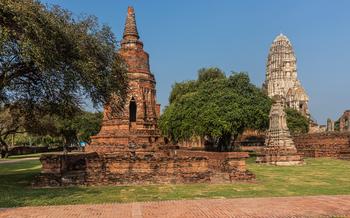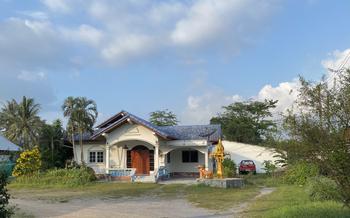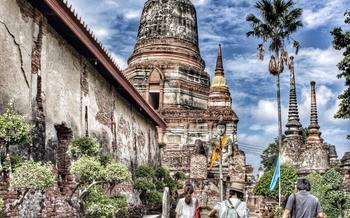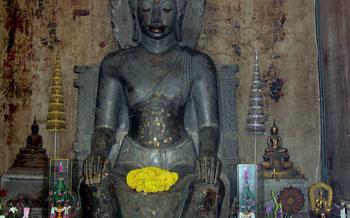
Wat Tham Sammit (Hellfire Cave)
- Wat Tham Sammit: A Journey into the Sacred Caves of Chonburi
- Religious Significance
- Exploring the Caves
- Local Traditions and Culture
- Festivals and Events
- Accommodation and Amenities
- Getting There and Around
- Visitor Etiquette and Respect
- Unique Experiences and Activities
- Sustainable Tourism Practices:
- Volunteering and Giving Back
- Insider Tip
- Insider Tip: Unveiling the Hidden Gems
Wat Tham Sammit: A Journey into the Sacred Caves of Chonburi
Wat Tham Sammit, also known as the Hellfire Cave Temple, is an ancient Buddhist temple nestled amidst the lush forests of Chonburi, Thailand. Steeped in history and cultural significance, the temple is renowned for its intricate Buddhist murals, sacred caves, and stunning natural surroundings. Legend has it that the temple was founded by a group of Buddhist monks who sought refuge in the caves during a time of great turmoil. They discovered that the caves emitted a warm glow, which they believed to be a sign from the heavens. Inspired by this divine revelation, they decided to build a temple on the site, transforming the caves into sacred chambers for meditation and spiritual retreat.
The architectural style of Wat Tham Sammit is a blend of traditional Thai and Khmer influences, featuring intricate carvings, colorful murals, and towering spires that reach towards the sky. The temple complex comprises several buildings, including the main shrine, the ordination hall, and the bell tower. The main shrine houses a revered Buddha image known as Luang Pho Sammit, which is believed to have miraculous powers. Over the centuries, Wat Tham Sammit has become a significant pilgrimage site for Buddhists from all over Thailand and beyond. It is not only a place of worship but also a center for meditation, spiritual learning, and cultural preservation.
Religious Significance
Wat Tham Sammit holds immense spiritual importance to Buddhists from Thailand and beyond. The temple is renowned as a sacred place of meditation and spiritual retreat, attracting numerous devotees seeking inner peace and enlightenment. Visitors can immerse themselves in the tranquil atmosphere of the temple, finding solace and serenity amidst the natural surroundings.
Throughout the year, the temple hosts various religious ceremonies and rituals that draw both local and international participants. These ceremonies showcase the rich traditions and beliefs of Thai Buddhism, allowing visitors to witness firsthand the vibrant expressions of faith and devotion. The temple's annual festivals, such as the Kathin Festival and the Makha Bucha Festival, are particularly significant events that celebrate important Buddhist holidays and attract large numbers of pilgrims and tourists alike.
The temple also serves as a center for Buddhist education, offering teachings, workshops, and meditation retreats for those seeking to deepen their understanding of the Dharma. Visitors can engage with resident monks and learn about Buddhist philosophy, meditation techniques, and the principles of mindfulness. The temple's commitment to preserving and promoting Buddhist traditions makes it a vital spiritual sanctuary for both local and international practitioners.
Exploring the Caves
Wat Tham Sammit is renowned for its extensive cave system, which adds to its mystique and spiritual allure. Venturing into these caves is a unique experience that allows visitors to delve deeper into the temple's sacredness and natural wonders.
The cave system comprises several chambers and tunnels, each adorned with intricate stalactites and stalagmites that have been formed over millions of years. The formations come in various shapes and sizes, resembling mythical creatures, human figures, or even Buddhist deities. The play of light and shadow within the caves creates a mesmerizing atmosphere, further enhancing the spiritual ambiance.
Beyond their aesthetic beauty, the caves hold historical and archaeological significance. They have been used for meditation and spiritual retreats for centuries, and evidence suggests that they were once inhabited by ancient hermits or monks seeking solitude and enlightenment. Visitors can still sense the palpable energy of these past inhabitants as they explore the caves.
Exploring the caves requires a certain level of fitness and agility, as some passages are narrow and require crawling or climbing. However, the rewards are immense, as visitors are treated to hidden chambers, secluded meditation spots, and breathtaking views of the surrounding landscape.
To ensure a safe and respectful exploration, visitors are advised to wear appropriate clothing and footwear, carry a flashlight or headlamp, and be mindful of their surroundings. It is also essential to respect the sanctity of the caves by maintaining silence and refraining from disturbing the natural formations.
Local Traditions and Culture
Wat Tham Sammit is deeply intertwined with the local community, serving as a spiritual and cultural hub for generations. The temple holds a special place in the hearts of the local people, who have passed down traditions and customs associated with the temple for centuries. These traditions reflect the unique blend of Buddhist beliefs and local customs that have shaped the cultural identity of the region.
One of the most significant cultural practices associated with the temple is the annual merit-making ceremony, known as "Tam Bun." During this ceremony, devotees gather at the temple to offer food, flowers, and other offerings to the monks. The ceremony is a symbol of gratitude and respect, and it also serves as a way for the community to come together and strengthen their bonds.
Another important tradition is the practice of meditation and spiritual retreats at the temple. Wat Tham Sammit is renowned for its serene atmosphere and natural beauty, making it an ideal place for those seeking spiritual guidance and inner peace. Visitors can participate in meditation sessions led by experienced monks or simply find a quiet spot within the temple grounds to reflect and connect with their inner selves.
The temple also plays a vital role in preserving and promoting local cultural heritage. It houses a collection of ancient artifacts, including Buddha images, scriptures, and traditional Thai musical instruments. These artifacts provide a glimpse into the rich history and cultural traditions of the region. The temple also hosts cultural events and performances throughout the year, showcasing local dances, music, and handicrafts. These events offer visitors an opportunity to experience the vibrant cultural heritage of the local community firsthand.
Festivals and Events
Wat Tham Sammit comes alive during its annual festivals and events, which offer a vibrant glimpse into local traditions and culture. The most notable festival is the Wat Tham Sammit Fair, held over several days in February or March. This grand celebration features colorful parades, traditional Thai dance performances, merit-making ceremonies, and a lively market selling local handicrafts, souvenirs, and delicious street food.
Another significant event is the Songkran Festival, also known as the Thai New Year, which takes place in April. During Songkran, the temple becomes a hub of activity as locals and visitors alike gather to celebrate with water fights, merit-making, and traditional processions.
Throughout the year, the temple also hosts various religious ceremonies and rituals, such as merit-making ceremonies and chanting sessions. Visitors are welcome to observe or participate in these ceremonies, which offer a deeper insight into Buddhist practices and beliefs.
Attending festivals and events at Wat Tham Sammit is a fantastic way to immerse oneself in the local culture, witness the vibrant Thai traditions, and create lasting memories of a truly unique and authentic experience.
Accommodation and Amenities
Wat Tham Sammit offers a range of accommodation options to suit different budgets and preferences. For those seeking a budget-friendly stay, there are several guesthouses and hostels located within walking distance of the temple. These accommodations provide basic amenities such as clean rooms, shared bathrooms, and Wi-Fi.
For a more comfortable experience, visitors can choose from a selection of mid-range hotels and resorts in the vicinity. These establishments offer private rooms with en-suite bathrooms, air conditioning, and additional amenities like swimming pools and fitness centers.
Within the temple complex itself, visitors will find basic amenities such as restrooms, drinking water stations, and a few small shops selling snacks, drinks, and souvenirs. There are also several restaurants and food stalls in the surrounding area, where visitors can savor delicious Thai cuisine and local specialties.
For a truly unique and immersive experience, consider staying in one of the temple's guesthouses. These accommodations offer a chance to live among the monks and participate in daily temple activities. Visitors will have the opportunity to learn about Buddhist teachings, meditation practices, and Thai culture while enjoying the tranquility of the temple grounds.
Getting There and Around
Reaching Wat Tham Sammit is a convenient journey from major cities in Thailand. From Bangkok, visitors can take a direct bus or train to Chonburi, followed by a short taxi or songthaew ride to the temple. Alternatively, renting a car or hiring a private driver offers flexibility and allows for exploration of nearby attractions. For those traveling from Pattaya, a direct bus or taxi ride directly to the temple is a convenient option. The temple complex is well-maintained, with accessible pathways and designated parking areas. Visitors with disabilities or limited mobility can request assistance from temple staff or utilize the available ramps and elevators. To fully explore the surrounding area, consider renting a bicycle or motorbike, which can be easily arranged through local rental shops. Combining a visit to Wat Tham Sammit with other nearby attractions, such as Khao Sam Roi Yot National Park or the Nong Nooch Tropical Botanical Garden, is a great way to make the most of your time in the region.
Visitor Etiquette and Respect
When visiting Wat Tham Sammit, it is crucial to be mindful of local customs and traditions to ensure a respectful and harmonious experience. Visitors should dress modestly, avoiding revealing or tight clothing, and remove their shoes before entering the temple grounds. It is considered disrespectful to point the soles of one's feet towards Buddha images or monks. Photography is permitted within the temple complex, but visitors should refrain from taking photos of monks or other individuals without their consent. It is also important to maintain a respectful demeanor, avoiding loud noises or disruptive behavior, as the temple is a place of worship and meditation. Visitors should be mindful of their impact on the environment, minimizing waste and avoiding littering. By observing these guidelines, visitors can contribute to preserving the sacredness of the temple and demonstrate their respect for the local culture and traditions.
Unique Experiences and Activities
Beyond the spiritual and historical significance of Wat Tham Sammit, visitors can immerse themselves in a range of unique experiences that offer a deeper connection to Thai culture and the natural beauty of the region.
For those seeking spiritual rejuvenation, the temple provides opportunities for meditation and yoga retreats within the serene surroundings of the temple complex. Guided meditation sessions allow visitors to learn and practice mindfulness techniques, while yoga classes amidst the peaceful atmosphere promote inner balance and well-being.
Nature enthusiasts can explore the surrounding forests and hills, where hiking trails lead to hidden waterfalls and breathtaking viewpoints. Visitors can immerse themselves in the lush greenery, encounter diverse wildlife, and capture stunning photographs of the picturesque landscapes.
For a unique cultural experience, visitors can participate in traditional Thai cooking classes offered by local experts. These hands-on sessions provide an opportunity to learn the art of preparing authentic Thai dishes, using fresh local ingredients and traditional cooking techniques. Visitors can savor the flavors of their creations while gaining insights into Thai culinary traditions.
Wat Tham Sammit also hosts special events and workshops throughout the year, offering visitors a chance to delve deeper into Thai culture and traditions. These events may include traditional dance performances, music concerts, or workshops on Thai handicrafts, such as silk weaving or flower arrangement. Participating in these events allows visitors to connect with the local community and gain a richer understanding of Thai heritage.
Sustainable Tourism Practices:
As a responsible traveler, it is essential to prioritize sustainability when visiting Wat Tham Sammit and the surrounding area. Here are some tips to minimize your environmental impact:
-
Reduce Waste: Avoid single-use plastics and opt for reusable water bottles and shopping bags. Dispose of waste properly in designated bins.
-
Conserve Water and Energy: Be mindful of your water usage and turn off lights and fans when not in use. Support hotels and restaurants that have water conservation measures in place.
-
Support Local Businesses: Choose to stay in locally-owned guesthouses or hotels that prioritize sustainability. Dine at local restaurants that use fresh, locally-sourced ingredients.
-
Respect the Environment: Tread lightly on the temple grounds and surrounding natural areas. Avoid disturbing wildlife or damaging plants. Respect the sacredness of the temple by following local customs and traditions.
Wat Tham Sammit actively promotes sustainable tourism practices to protect the environment. The temple has implemented waste reduction initiatives, uses energy-efficient lighting, and supports local businesses that share its commitment to sustainability. By embracing these practices, you can contribute to the preservation of this sacred site and its surroundings for future generations.
Volunteering and Giving Back
Wat Tham Sammit and the surrounding community welcome visitors who are interested in volunteering their time and skills to make a positive impact. There are various ways in which travelers can contribute to the preservation and development of the temple. Visitors can participate in educational programs that focus on teaching local children about Thai culture and traditions. Alternatively, they can assist with conservation initiatives aimed at protecting the natural environment surrounding the temple.
Insider Tip
For a truly unique experience, visitors should consider volunteering at Wat Tham Sammit during the annual temple fair, which typically takes place in November or December. During this time, the temple comes alive with a vibrant atmosphere as locals and visitors alike gather to celebrate Thai culture and traditions. Volunteers can assist with various tasks such as setting up food stalls, organizing games and activities for children, and helping with the overall coordination of the event. This is a fantastic opportunity to immerse oneself in the local community and make a meaningful contribution to the preservation of Wat Tham Sammit's rich cultural heritage.
Insider Tip: Unveiling the Hidden Gems
For an unforgettable experience, venture beyond the main temple complex and explore the lesser-known corners of Wat Tham Sammit. Discover a secluded meditation cave tucked away in the lush forest, where you can find tranquility and inner peace amidst the natural surroundings. Ascend to the viewpoint atop the hill for breathtaking panoramic vistas of the temple grounds and the surrounding countryside.
For a truly immersive cultural experience, participate in a merit-making ceremony at the temple. Offer food and other necessities to the monks and receive their blessings. This sacred ritual is a meaningful way to connect with the local traditions and contribute to the well-being of the temple community.
To savor the authentic flavors of the region, venture into the nearby village and sample the local delicacies. Indulge in freshly caught seafood, fragrant curries, and tropical fruits. Don't miss the opportunity to try the unique regional specialties, such as the sweet and tangy "Khanom Sai Nam Pla," a delicious fish sauce dessert.
Whether you seek spiritual enlightenment, cultural immersion, or simply a chance to unwind in nature, Wat Tham Sammit offers a wealth of hidden gems waiting to be discovered. Embrace the opportunity to explore beyond the ordinary and create lasting memories in this sacred and enchanting place.








